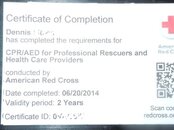- Messages
- 7,660
- Reaction score
- 4,717
- # of dives
- 200 - 499
I'd use an AED in a heartbeat on a wet boat if someone needed it.
Background: The US grounds one leg of a transformer and calls it "Neutral". This means that the "Hot" lead is guaranteed to be dangerous with respect to ground. The UK and several other countries isolate (float) both lines of the transformer from ground, thus either (or neither) may or may not be dangerous with respect to ground.
An AED is not grounded. The shock potential is developed between the two leads, furthermore the AED has to sense an arrhythmia to fire. If it is shorted out you get no shock.
25 V RMS (35 V peak) is safe. Extra-low voltage - Wikipedia, the free encyclopedia
If you want more go with OSHA: https://www.osha.gov/pls/oshaweb/owadisp.show_document?p_id=9871&p_table=standards
Repeat: I wouldn't hesitate to use an AED in a wet environment if someone needed it, but I'd do a really good "CLEAR!".
---------- Post added March 30th, 2015 at 04:41 PM ----------
Just to make sure that everyone is on the same page, an AED was never designed to re-start your heart. Its only function is to STOP your heart. http://www.heart.org/idc/groups/heart-public/@wcm/@hcm/documents/downloadable/ucm_300340.pdf
Background: The US grounds one leg of a transformer and calls it "Neutral". This means that the "Hot" lead is guaranteed to be dangerous with respect to ground. The UK and several other countries isolate (float) both lines of the transformer from ground, thus either (or neither) may or may not be dangerous with respect to ground.
An AED is not grounded. The shock potential is developed between the two leads, furthermore the AED has to sense an arrhythmia to fire. If it is shorted out you get no shock.
25 V RMS (35 V peak) is safe. Extra-low voltage - Wikipedia, the free encyclopedia
If you want more go with OSHA: https://www.osha.gov/pls/oshaweb/owadisp.show_document?p_id=9871&p_table=standards
Repeat: I wouldn't hesitate to use an AED in a wet environment if someone needed it, but I'd do a really good "CLEAR!".
---------- Post added March 30th, 2015 at 04:41 PM ----------
Just to make sure that everyone is on the same page, an AED was never designed to re-start your heart. Its only function is to STOP your heart. http://www.heart.org/idc/groups/heart-public/@wcm/@hcm/documents/downloadable/ucm_300340.pdf






